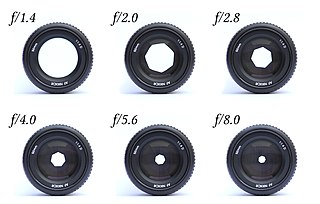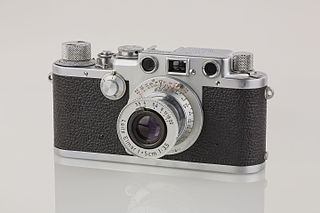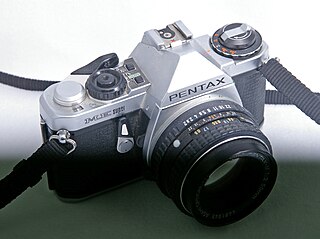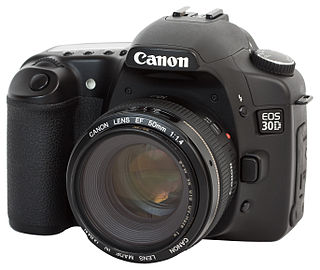
In optics, an aperture is a hole or an opening through which light travels. More specifically, the aperture and focal length of an optical system determine the cone angle of the bundle of rays that come to a focus in the image plane.

A camera is an optical instrument used to capture and store images and videos, either digitally via an electronic image sensor, or chemically via a light-sensitive material such as photographic film. As a pivotal technology in the fields of photography and videography, cameras have played a significant role in the progression of visual arts, media, entertainment, surveillance, and scientific research. The invention of the camera dates back to the 19th century and has since evolved with advancements in technology, leading to a vast array of types and models in the 21st century.

In photography, shutter speed or exposure time is the length of time that the film or digital sensor inside the camera is exposed to light when taking a photograph. The amount of light that reaches the film or image sensor is proportional to the exposure time. 1⁄500 of a second will let half as much light in as 1⁄250.

In photography, exposure is the amount of light per unit area reaching a frame of photographic film or the surface of an electronic image sensor. It is determined by shutter speed, lens F-number, and scene luminance. Exposure is measured in units of lux-seconds, and can be computed from exposure value (EV) and scene luminance in a specified region.

In photography, flash synchronization or flash sync is the synchronizing the firing of a photographic flash with the opening of the shutter admitting light to photographic film or electronic image sensor.

The Canon EOS 20D is an 8.2-megapixel semi-professional digital single-lens reflex camera, initially announced on 19 August 2004 at a recommended retail price of US$1,499. It is the successor of the EOS 10D, and was succeeded by the EOS 30D in August 2006. It accepts EF and EF-S lenses and uses an APS-C sized image sensor.
The science of photography is the use of chemistry and physics in all aspects of photography. This applies to the camera, its lenses, physical operation of the camera, electronic camera internals, and the process of developing film in order to take and develop pictures properly.

When setting photoflash exposures, the guide number (GN) of photoflash devices is a measure photographers can use to calculate either the required f‑stop for any given flash-to-subject distance, or the required distance for any given f‑stop. To solve for either of these two variables, one merely divides a device's guide number by the other.

Aperture priority, often abbreviated A or Av on a camera mode dial, is a mode on some cameras that allows the user to set a specific aperture value (f-number) while the camera selects a shutter speed to match it that will result in proper exposure based on the lighting conditions as measured by the camera's light meter. This is different from manual mode, where the user must decide both values, shutter priority where the user picks a shutter speed with the camera selecting an appropriate aperture, or program mode where the camera selects both.

In photography, a shutter is a device that allows light to pass for a determined period, exposing photographic film or a photosensitive digital sensor to light in order to capture a permanent image of a scene. A shutter can also be used to allow pulses of light to pass outwards, as seen in a movie projector or a signal lamp. A shutter of variable speed is used to control exposure time of the film. The shutter is constructed so that it automatically closes after a certain required time interval. The speed of the shutter is controlled either automatically by the camera based on the overall settings of the camera, manually through digital settings, or manually by a ring outside the camera on which various timings are marked.

Image noise is random variation of brightness or color information in images, and is usually an aspect of electronic noise. It can be produced by the image sensor and circuitry of a scanner or digital camera. Image noise can also originate in film grain and in the unavoidable shot noise of an ideal photon detector. Image noise is an undesirable by-product of image capture that obscures the desired information. Typically the term “image noise” is used to refer to noise in 2D images, not 3D images.
Autobracketing is a feature of some more advanced cameras, whether film or digital cameras, particularly single-lens reflex cameras, where the camera will take several successive shots with slightly different settings. The images may be automatically combined, for example into one high-dynamic-range image, or they may be stored separately so the best-looking pictures can be picked later from the batch. When the photographer achieves the same result by changing the camera settings between each shot, this is simply called bracketing.

The Canon EOS 30D is an 8.2-megapixel semi-professional digital single-lens reflex camera, initially announced on February 21, 2006. It is the successor of the Canon EOS 20D, and is succeeded by the EOS 40D. It can accept EF and EF-S lenses, and like its predecessor, it uses an APS-C sized image sensor, so it does not require the larger imaging circle necessary for 35 mm film and 'full-frame' digital cameras.

Live preview is a feature that allows a digital camera's display screen to be used as a viewfinder. This provides a means of previewing framing and other exposure before taking the photograph. In most such cameras, the preview is generated by means of continuously and directly projecting the image formed by the lens onto the main image sensor. This in turn feeds the electronic screen with the live preview image. The electronic screen can be either a liquid crystal display (LCD) or an electronic viewfinder (EVF).

A mode dial or camera dial is a dial used on digital cameras to change the camera's mode. Most digital cameras, including dSLR and SLR-like cameras, support modes, selectable either by a rotary dial or from a menu. On point-and-shoot cameras which support modes a range of scene types is offered. On dSLR cameras and SLR-like cameras, mode dials usually offer access to manual settings. The more compact point-and-shoot cameras, and cameras offering a great many modes, do not have mode dials, using menus instead. Some SLR lenses themselves offer control over things such as aperture, reducing the need for mode support in the camera body.

The Canon EOS 100 is a 35 mm autofocus SLR camera introduced by Canon in 1991. It was marketed as the EOS Elan in North America. It was the second camera in the EOS range to be targeted at advanced amateur photographers, replacing the EOS 650.

The Minolta 9000 AF is a professional Single-lens reflex autofocus camera, introduced by Minolta in August 1985. It was both Minolta's and the world's first professional autofocus SLR. It was called Minolta Maxxum 9000 in the US and Minolta α-9000 in Japan.

Most digital cameras support the ability to choose among a number of configurations, or modes for use in various situations. Professional DSLR cameras provide several manual modes; consumer point-and-shoot cameras emphasize automatic modes; amateur prosumer cameras often have a wide variety of both manual and automatic modes.

Landscape photography shows the spaces within the world, sometimes vast and unending, but other times microscopic. Landscape photographs typically capture the presence of nature but can also focus on human-made features or disturbances of landscapes. Landscape photography is done for a variety of reasons. Perhaps the most common is to recall a personal observation or experience while in the outdoors, especially when traveling. Others pursue it particularly as an outdoor lifestyle, to be involved with nature and the elements, some as an escape from the artificial world.

Canon EOS 1100D is a 12.2-megapixel digital single-lens reflex camera announced by Canon on 7 February 2011. It is known as the EOS Kiss X50 in Japan and the EOS Rebel T3 in the Americas. The 1100D is Canon's most basic entry-level DSLR, and introduces movie mode to other entry level DSLRs. It replaced the 1000D and is also the only Canon EOS model currently in production that is not made in Japan but in Taiwan, aside from the EOS Rebel T4i.






















